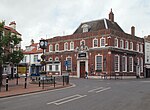Whinhill Lock
Buildings and structures in the East Riding of YorkshireGrade II listed buildings in the East Riding of YorkshireLocks on the Driffield NavigationTransport in the East Riding of YorkshireUse British English from January 2020

Whinhill Lock was built as part of the Driffield Navigation in the East Riding of Yorkshire, England. It was originally opened in 1770, and was restored in 2004.
Excerpt from the Wikipedia article Whinhill Lock (License: CC BY-SA 3.0, Authors, Images).Whinhill Lock
B1249,
Geographical coordinates (GPS) Address Nearby Places Show on map
Geographical coordinates (GPS)
| Latitude | Longitude |
|---|---|
| N 53.99681 ° | E -0.39814 ° |
Address
B1249
YO25 5XR , Skerne and Wansford
England, United Kingdom
Open on Google Maps










